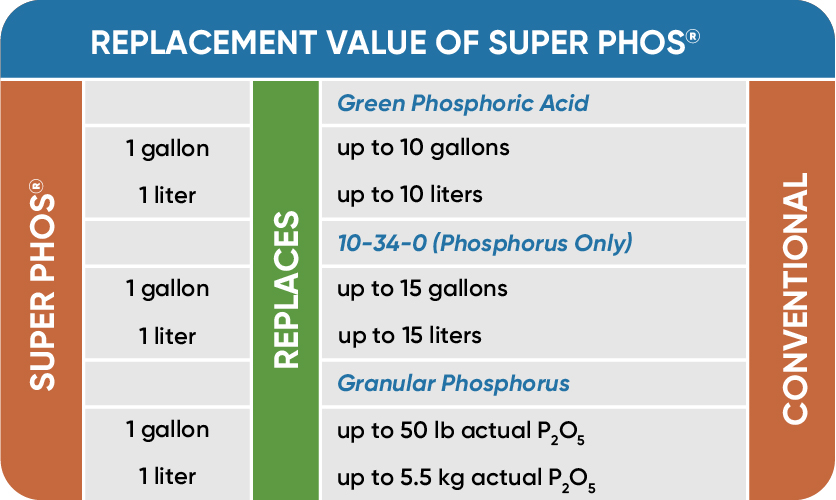Super Phos
Benefits of Use:
- 15 times more efficient than conventional 10-34-0
- Resists “tie-up” with calcium or aluminum to remain water soluble and available to plant roots
- Moves with irrigation water to aid in proper placement
- Can be tank-mixed to improve availability of other phosphorus solutions
- Is non-salt-forming
- Aids in phosphorus uptake in cold or waterlogged soils
- Is useful in the cleaning and maintenance of drip irrigation systems
- Aids in phosphorus uptake in high pH or calcareous soils
Deficiency Symptoms-When to Apply:
- Slow growth; stunted plants
- Purplish coloration on foliage of some plants (older leaves first)
- Dark green coloration with tips of leaves dying
- Poor grain, fruit, or seed development
FAQs
Related Products
Related Case Studies

Super Phos® Multi-State Midwest Trial
Background Application of phosphorus (P) fertilizers—such as triple super phosphate (TSP), monoammonium phosphate (MAP), diammonium phosphate (DAP), liquid ammonium polyphosphate (APP), and other forms—can be inefficient and, at times, not environmentally friendly. A technology that can mitigate these P fertilizer challenges without compromising yield and return on investment is highly desirable. Huma® Super Phos® is...

Huma® Products on Sugar Cane Result in 14x Less P and 32x Less K Required, Plus Increased Yield and Net Return
Background Humates and plant growth stimulators can positively influence a crop such as sugar cane to produce a higher yield. Objective The focus of this study was to observe how fall application of Huma® products Fertil Soil®, a source of soil nutrients and humates, and Breakout®, which stimulates growth, would affect sugar cane production. The...

Huma® Program Increases Strawberry Yields 13%, With an Increased Return of > $3,400/acre
Objective This field trial assessed the effects of an additional 4 foliar applications of Huma® products on the yield of Portola strawberries when compared with the grower’s standard crop nutrition program. Materials & Methods This trial was set up in a complete randomized-block design conducted during the growing season of July 18 through November 28...
Related Blog Posts

Evaluation of Micro-Carbon Technology-Based P Fertilizer, SUPER PHOS®, in Spring Wheat

Huma Gro® Nutrient and Fumigation Replacement Program Increases Strawberry Yields 97%
Conducted by: Pacific Ag Research Huma Gro® Products: Ultra-Precision™ Blend (Fresca CA Strawberry Mix), Promax®, and Zap® OBJECTIVE This field trial assessed the effects on strawberry yields of replacing field fumigation with periodic applications of Huma Gro® Promax® and Zap® and replacing a grower’s standard fertilizer program with irrigation-applied Ultra-Precision™ blended liquid Huma Gro® crop...

This Week in Ag #16
If the TV show MythBusters ever did a program on farming, there are several common myths about farmers they could bust.







